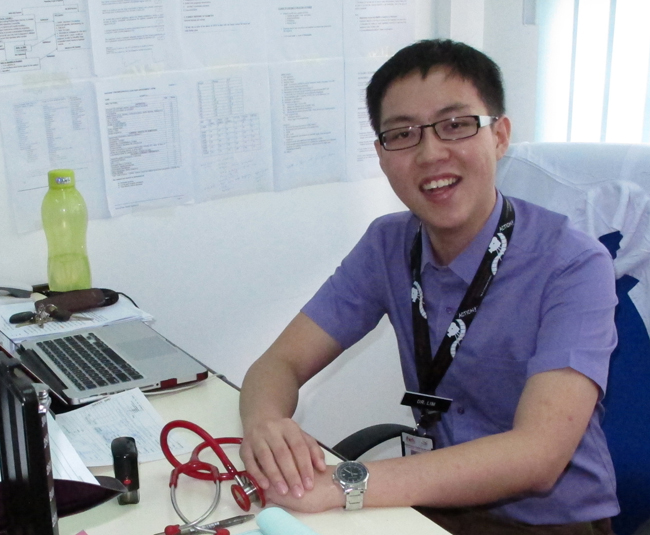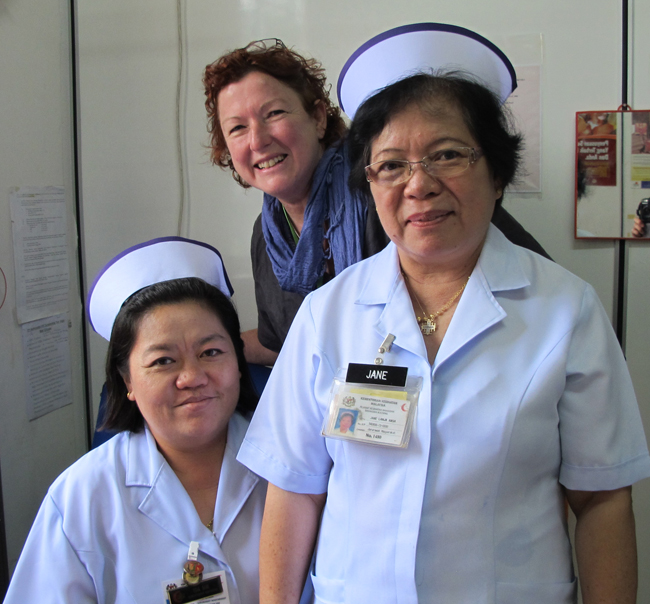Rural health clinic visits in Kuching, Malaysia
 Photo: Privileged visitors with staff at the Klinic Kesihatan at Braang Bayur
Photo: Privileged visitors with staff at the Klinic Kesihatan at Braang Bayur
At the recent WONCA Asia Pacific region conference, visits to rural health clinics were offered by the Host Organising Committee. The WONCA Editor joined another Australian colleague and four colleagues from Japan on one of the visit programs. Out local group leader was Dr Juslina Omar, who patiently dealt with our many questions on the local Health system.

At the first clinic, the Klinic Kesihatan at Braang Bayur, we met Dr Geng Yan LIM (photo at right), who not only served the main clinic but regularly made visits to remote clinics.
The Braang Bayur clinic is a Government primary care facility. The actual clinic premises were new, well equipped and spacious. Everything any patient could expect including basic laboratory tests and a dispensary was onsite. A dental clinic is proposed for the future. To be seen at the clinic a patient must pay 1 Malaysian Ringgit (about 30 US cents) and this covers the consult and medications. Children coming for routine child health visits and vaccination and those over 65 years old, as well as pregnant women are free.
Doctors stay for a minimum of one year. Dr Lim was enthusiastic about his work and was a wonderful host, responding fully to our questions and curiosity. Medically however, Dr Lim reports that the work is more challenging than in the city and there are limited tertiary facilities. Patients are screened by Assistant Medical Officers, but Doctor Lim sees paediatric patient and all women for antenatal care. Common clinical issues are arthritis and NCDs. Difficulties are living in rural community in the week and going into town on weekend. Lack of entertainment is an issue as the clinic and the Doctor’s house are not in a large village.

Our second clinic visit was to a Maternal and Child health clinic – a nurse led clinic run by 15 nurses led by the Clinic Matron Iya Ratu.
Photo: WONCA Editor, Karen Flegg with two of the nursing staff at the clinic.
The clinic sees 80-100 patients daily. There is no doctor, no laboratory and no medications available (except haemactinics for pregnant women) as the focus really is antenatal and postnatal care and child health. The staff follow up all women rigorously in order to provide the best and recommended level of care. Immunisations for children are done.
The clinic seemed an excellent example of the Government addressing the Millennium Development Goals by providing services that appeal to patients, in an environment that is friendly to them.

The third and final clinic visited on the day was a private medical practice of Dr LIM Meng Lang, namely the Siburan Union clinic. Dr Lim has worked here for 25 years as a solo GP. He opens seven days per week, most days in the morning and afternoon. The local population is about 30,000 people. Also serving that population is one Government clinic, another private clinic and one Chinese practitioner clinic.
Photo: Dr Lim meng Lang with Dr Kuni Shiina from Japan playing the patient.
Dr Lim sees patient as they walk in - usually 30-40 per day. He dispenses his own medications and to cover the cost of that and the visit to him, patients usually pay 30 to 40 Malaysian Ringgit per visit (estimated as 1-3% of their monthly income). He does the occasional house call.
Dr Lim has collated data on his practice and has a powerpoint presentation ready for his visitors. I notice the commonest presentations are respiratory (39%), mostly URTI, and the most seen demographic are the under 5 year old age group.
As for the Government clinic, the practice is well set up with spacious consulting rooms and all necessary equipment. While the clinic is not in a new building, it is required that all aspects meet the Private Practice Facilities Act. Dr Lim’s work is also bound by the Medical Act and Poisons Act, for dispensing.
It is a co-incidence that both doctors we met we Dr Lim – but they shared and enthusiasm and passion for their work and desire to do the best for their patients. Both provide a much needed service in places outside Kuching and where any patient needing the hospital must be sent the 30-60 minute drive into the city. We were impressed by the services we saw but our wonderful host doctors report that they were impressed by the questions our group asked and the understanding shown by members of the group who could identify with some of the challenges that are common to all GPs regardless of where they practise!
On behalf of the group of Japanese and Australian visitors (again a co-incidence), sincere thanks to all at the three clinics and to the two Drs Lim and our hostess Dr Omar. As one of our group said - the visits were the high point of the conference.
Dr Karen Flegg
WONCA Editor